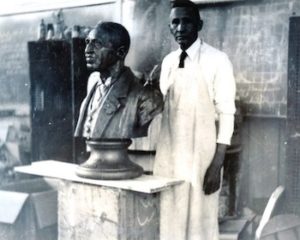
Isaac Hathaway (with bust of)
George Washington Carver
*The birth of Isaac Hathaway in 1872 is marked on this date. He was a Black Sculptor, Ceramicist, Illustrator, and Teacher.
Isaac Scott Hathaway was from Lexington, KY, and was one of three children born to Reverend Hathaway and his wife. His mother died when he was only at age two. Their father raised Isaac and his two sisters, Fannie and Eva. Hathaway's childhood was packed with questions. When he was nine, while visiting a museum containing busts of famous white Americans, he asked his father where the bust of his hero, Frederick Douglass, was. His father replied that there were no trained Negro sculptors to mold prominent Negro people. Young Hathaway responded, "I am going to model busts of Negroes and put them where people can see them."
Hathaway went to Chandler College in Lexington, Kentucky, and Pittsburg Normal College in Pittsburg, Kansas, where he studied ceramics. He also enrolled in the Art Department of the New England Conservatory of Music. He also studied at the Cincinnati Art Academy in Cincinnati, Ohio; Ceramics at the State University of Kansas and the College of Ceramics of the State University of New York at Alfred. Hathaway used his diversified education and art background as an elementary school teacher in Kentucky. His art education and creative genius helped him prepare visual plaster models for his classroom.
Soon, his work gained notice, and many of his peers advised him to develop a company that could distribute "sculptural products on a national scale." At first, Hathaway’s company became known as the Afro Art Company and later the Isaac Hathaway Art Company. He produced busts of many famous and prominent African Americans for distribution to schools and elsewhere. Among his works were Booker T. Washington, Frederick Douglass, Richard Allen, Paul Laurence Dunbar, George Washington Carver, and C.C. Spaulding. He molded plaques and masks, which could be hung on walls of colleges, churches, and businesses. Hathaway was also sculptured in bronze metal upon request.
By 1915, Hathaway's talents had elevated him to be among the first to introduce the art of ceramics into the college curricula in the United States. He was the founding member of the Department of Ceramics at Tuskegee Institute in Alabama, where he stayed from 1937-1947. On August 7, 1946, President Harry S. Truman authorized a commission by the U.S. Mint of a fifty-cent piece "to commemorate the life and perpetuate the ideas and teachings of Booker T. Washington. Isaac Hathaway was chosen as the designer of the Booker T. Washington coin, thus becoming the first African American to design a U.S. coin. He was also chosen as the George Washington Carver commemorative fifty-cent piece designer in 1951.
He once said he believed "that the art of a people not only conveys their mental, spiritual, and civic growth to posterity, but convinces their contemporaries that they can best portray in crystallization their feelings, aspirations, and desires." Many visual artists who deserve recognition as worthy contributors to the arts have been ignored or sparsely cited in many standard reference books and research bibliographies. One of those neglected names was Isaac Scott Hathaway. This exclusion was recently brought to light by Kendrick Moore, curator of the Isaac Scott Hathaway Collection, who was a resident of Oklahoma City and formerly a resident of Louisville, Kentucky. Isaac Hathaway died on March 12, 1967.
Isaac Scott Hathaway Museum, Inc.
P.O. Box 910036
Lexington, KY 40591-0036
859-361-2813